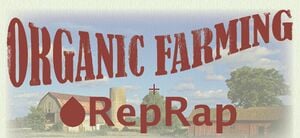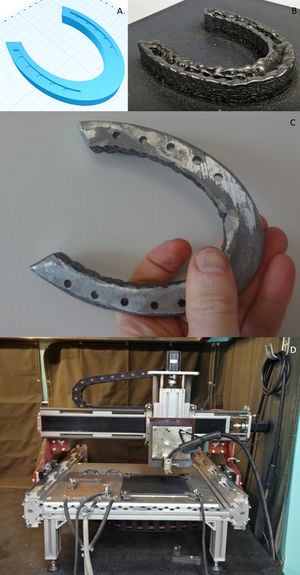
There is growing evidence that low-cost open-source 3-D printers can reduce costs by enabling distributed manufacturing of substitutes for both specialty equipment and conventional mass-manufactured products. The rate of 3-D printable designs under open licenses is growing exponentially and there are already hundreds of designs applicable to small-scale organic farming. It has also been hypothesized that this technology could assist sustainable development in rural communities that rely on small-scale organic agriculture. To gauge the present utility of open-source 3-D printers in this organic farm context both in the developed and developing world, this paper reviews the current open-source designs available and evaluates the ability of low-cost 3-D printers to be effective at reducing the economic costs of farming.This study limits the evaluation of open-source 3-D printers to only the most-developed fused filament fabrication of the bioplastic polylactic acid (PLA). PLA is a strong biodegradable and recyclable thermoplastic appropriate for a range of representative products, which are grouped into five categories of prints: handtools, food processing, animal management, water management and hydroponics. The advantages and shortcomings of applying 3-D printing to each technology are evaluated. The results show a general technical viability and economic benefit to adopting open-source 3-D printing for any of the technologies, although the individual economic impact is highly dependent on needs and frequency of use on a specific farm. Capital costs of a 3-D printer may be saved from on-farm printing of a single advanced analytical instrument in a day or replacing hundreds of inexpensive products over a year. In order for the full potential of open-source 3-D printing to be realized to assist organic farm economic resiliency and self-sufficiency, future work is outlined in five core areas: designs of 3-D printable objects, 3-D printing materials, 3-Dprinters, software and 3-D printable repositories.
Keywords: 3-D printing; agricultural tools; distributed manufacturing; farm equipment; intensive agriculture; small farms; Open Source Appropriate Technology
See also[edit | edit source]

- Open source 3-D printing of OSAT
- Mobile Open-Source Solar-Powered 3-D Printers for Distributed Manufacturing in Off-Grid Communities
- Corn sheller
- Open Source 3D-Printable Planetary Roller Screw for Food Processing Applications
- Life-cycle economic analysis of distributed manufacturing with open-source 3-D printers
- Feeding Everyone No Matter What
- Delta Build Overview:MOST
- Open Source Ecology
- Applications of Open Source GMAW-Based Metal 3-D Printing
- Open-Source Script for Design and 3D Printing of Porous Structures for Soil Science
News[edit | edit source]
- 3D Printing Low-Cost Tools for Organic Farmers in the Developing World - 3D Printing Industry
- The advantages of RepRap 3D printing on farms in the developing world - 3Ders
- 3D Printing Offers Economic Advantages to Third World Farmers - Inside 3D Printing
- Open mapping for sustainability, 3D printing on the farm, and more open source news - Opensource.com
- 3D print.com
- The advantages of RepRap 3D printing on farms - Open Electronics
- La agricultura, un campo de cultivo para la Impresión 3D - HW Libre
- Disrupted agriculture – farming and IoT combine to beat food insecurity -iDisrubuted
- 3D printers may be the next best piece of farm equipment - Ontario Farmer





